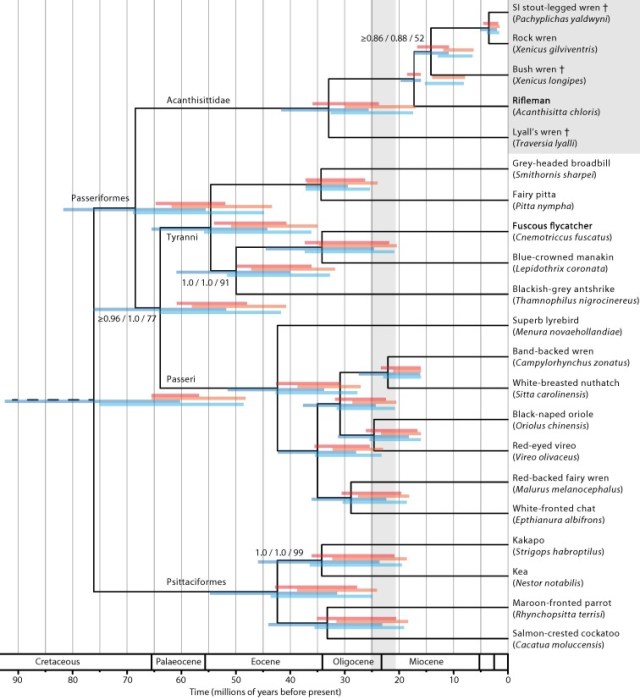The order Passeriformes, commonly known as “perching birds” or “songbirds,” contains over half of all known avian species. Sister to all other Passeriformes are the acanthisittid wrens, a small and enigmatic family of New Zealand endemics. Though their providential phylogenetic position makes them an important taxon for understanding avian diversification more broadly, research efforts have been hindered by the family’s other notable attribute: a sad history of extinction.

A female rifleman (Acanthisitta chloris), South Island, New Zealand. Photo credit digitialtrails.
You’re probably at least passingly familiar with the wrens’ woes because of the the well-known story of the Stephens Island Wren, Traversia lyalli, apocryphally eliminated within a decade of its discovery by a single cat named Tibble. This tragedy is emblematic of the family’s broader decline, with five of seven known acanthisittid wrens becoming extinct since the arrival of humans in New Zealand. And because these extinctions occurred prior to modern tissue collection practices, previous phylogenetic studies have largely relied on morphological characters — data that proved insufficient to resolve many relationships.
Now, however, Kieren Mitchell and colleagues have clarified the evolutionary history of the group with nearly-complete mitochondrial genomes of four acanthisittid species, extracted with ancient DNA techniques from subfossil remains. After first assembling the mitochondrial genome of the extant species Xenicus gilviventris with long template PCR, they enriched libraries of mtDNA extracted from bone fragments from three extinct acanthisittids using biotinylated RNA baits, mapping reads against a previously published mitogenome of the other surviving rock wren, Acanthisitta chloris. These data were then used in phylogenetic reconstructions with mitogenomes of species from two different tribes within the passeriformes, and parrots. (Parrots are sister to passeriformes and therefore an obvious choice of outgroup.)

Relationships among acanthisittids, major passerine tribes, and parrots, inferred from mitogenomes. Figure 1., Mitchell et al. 2016
Like all good phylogenetic studies, the authors’ results go beyond simply building a new or better tree for the family. In addition to resolving polytomies, revealing novel relationships, and suggesting taxonomic revisions accordingly, their cautious and well-justified molecular clock analysis provides insight on the influence of Gondwanan vicariance on passerines, and evidence against the controversial hypothesis of a complete marine inundation of New Zealand during the Oligocene. But to me, the study has the most resonance an example of our increasing ability to recover genomic data from extinct organisms — ameliorating slightly, perhaps, the scientific sting of their loss.
References:
Mitchell, K.J., Wood, J.R., Llamas, B., McLanachan, P.A., Olga, K., Scofield, R.P., Worthy, T.H., Cooper, A. 2016. Ancient mitochondrial genomes clarify the evolutionary history of New Zealand’s enigmatic acanthisittid wrens. Molecular Phylogenetics and Evolution. DOI: 10.1016/j.ympev.2016.05.038
Worthy, T.H., Hand, S.J., Nguyen, J.M.T., Tennyson, A.J.D., Worhty, J.P., Scofield, R.OP., Boles, W.E., Archer, M. 2010. Biogeographical and phylogenetic implications of an early Miocene wren (Aves: Passeriformes: Acanthisittidae) from New Zealand. Journal of Vertebrate Paleontology. DOI: 10.1080/02724631003618033
